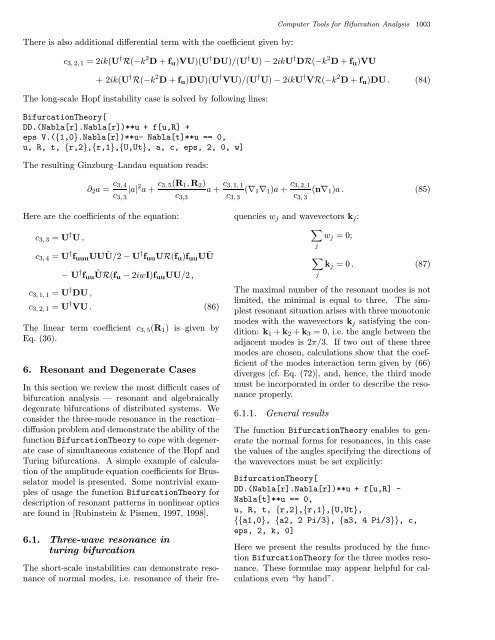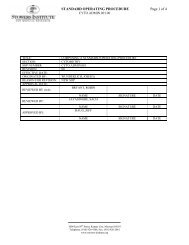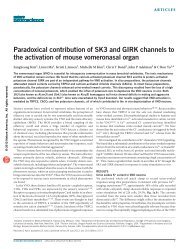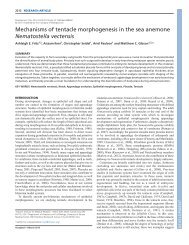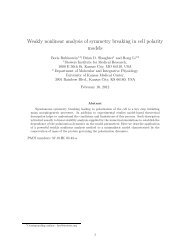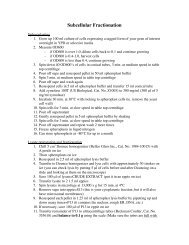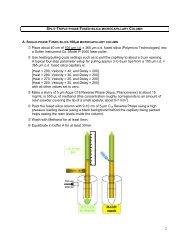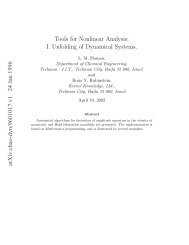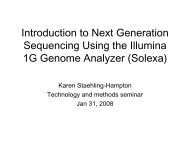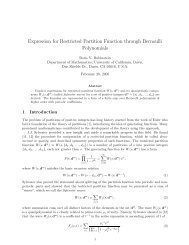Computer Tools for Bifurcation Analysis: General Approach with
Computer Tools for Bifurcation Analysis: General Approach with
Computer Tools for Bifurcation Analysis: General Approach with
Create successful ePaper yourself
Turn your PDF publications into a flip-book with our unique Google optimized e-Paper software.
There is also additional differential term <strong>with</strong> the coefficient given by:<br />
<strong>Computer</strong> <strong>Tools</strong> <strong>for</strong> <strong>Bifurcation</strong> <strong>Analysis</strong> 1003<br />
c 3, 2, 1 =2ik(U † R(−k 2 D + f u )VU)(U † DU)/(U † U) − 2ikU † DR(−k 2 D + f u )VU<br />
+2ik(U † R(−k 2 D + f u )DU)(U † VU)/(U † U) − 2ikU † VR(−k 2 D + f u )DU . (84)<br />
The long-scale Hopf instability case is solved by following lines:<br />
<strong>Bifurcation</strong>Theory[<br />
DD.(Nabla[r].Nabla[r])**u + f[u,R] +<br />
eps V.({1,0}.Nabla[r])**u- Nabla[t]**u == 0,<br />
u, R, t, {r,2},{r,1},{U,Ut}, a, c, eps, 2, 0, w]<br />
The resulting Ginzburg–Landau equation reads:<br />
∂ 2 a = c 3, 4<br />
c 3, 3<br />
|a| 2 a + c 3, 5(R 1 , R 2 )<br />
c 3,3<br />
a + c 3, 1, 1<br />
c 3, 3<br />
(∇ 1 ∇ 1 )a + c 3, 2, 1<br />
c 3, 3<br />
(n∇ 1 )a. (85)<br />
Here are the coefficients of the equation:<br />
c 3, 3 = U † U ,<br />
c 3, 4 = U † f uuu UUŨ/2 − U† f uu UR(f u )f uu UŨ<br />
− U † f uu ŨR(f u − 2iwI)f uu UU/2 ,<br />
c 3, 1, 1 = U † DU ,<br />
c 3, 2, 1 = U † VU . (86)<br />
The linear term coefficient c 3, 5 (R 1 ) is given by<br />
Eq. (36).<br />
6. Resonant and Degenerate Cases<br />
In this section we review the most difficult cases of<br />
bifurcation analysis — resonant and algebraically<br />
degenrate bifurcations of distributed systems. We<br />
consider the three-mode resonance in the reaction–<br />
diffusion problem and demonstrate the ability of the<br />
function <strong>Bifurcation</strong>Theory to cope <strong>with</strong> degenerate<br />
case of simultaneous existence of the Hopf and<br />
Turing bifurcations. A simple example of calculation<br />
of the amplitude equation coefficients <strong>for</strong> Brusselator<br />
model is presented. Some nontrivial examples<br />
of usage the function <strong>Bifurcation</strong>Theory <strong>for</strong><br />
description of resonant patterns in nonlinear optics<br />
are found in [Rubinstein & Pismen, 1997, 1998].<br />
6.1. Three-wave resonance in<br />
turing bifurcation<br />
The short-scale instabilities can demonstrate resonance<br />
of normal modes, i.e. resonance of their frequencies<br />
w j and wavevectors k j :<br />
∑<br />
w j =0;<br />
j<br />
∑<br />
j<br />
k j =0. (87)<br />
The maximal number of the resonant modes is not<br />
limited, the minimal is equal to three. The simplest<br />
resonant situation arises <strong>with</strong> three monotonic<br />
modes <strong>with</strong> the wavevectors k j satisfying the condition:<br />
k 1 + k 2 + k 3 = 0, i.e. the angle between the<br />
adjacent modes is 2π/3. If two out of these three<br />
modes are chosen, calculations show that the coefficient<br />
of the modes interaction term given by (66)<br />
diverges [cf. Eq. (72)], and, hence, the third mode<br />
must be incorporated in order to describe the resonance<br />
properly.<br />
6.1.1. <strong>General</strong> results<br />
The function <strong>Bifurcation</strong>Theory enables to generate<br />
the normal <strong>for</strong>ms <strong>for</strong> resonances, in this case<br />
the values of the angles specifying the directions of<br />
the wavevectors must be set explicitly:<br />
<strong>Bifurcation</strong>Theory[<br />
DD.(Nabla[r].Nabla[r])**u + f[u,R] -<br />
Nabla[t]**u == 0,<br />
u, R, t, {r,2},{r,1},{U,Ut},<br />
{{a1,0}, {a2, 2 Pi/3}, {a3, 4 Pi/3}}, c,<br />
eps, 2, k, 0]<br />
Here we present the results produced by the function<br />
<strong>Bifurcation</strong>Theory <strong>for</strong> the three modes resonance.<br />
These <strong>for</strong>mulae may appear helpful <strong>for</strong> calculations<br />
even “by hand”.


